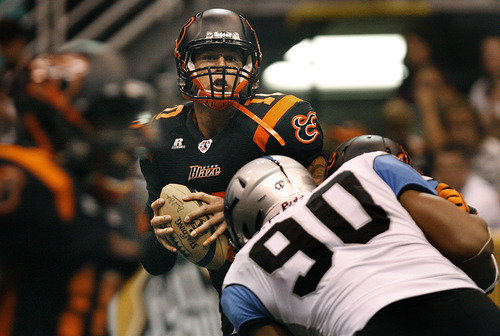This is an archived article that was published on sltrib.com in 2011, and information in the article may be outdated. It is provided only for personal research purposes and may not be reprinted.
West Valley City • It was nearly the end of the second hour of the Utah Blaze's final radio show of the season. The show was being broadcast from NYPD Pizza, and the place was emptying out.
"When the players go, the fans usually go with them," said coach Ron James, sitting at a table with owner Logan Hunter and director of player personnel Karl Bates. "Hopefully we'll see them next year."
The lockers may be cleaned out, and the turf may be rolled up, but the Blaze have an offseason mission in mind: keeping the team relevant.
The 2010-11 offseason was all about change: The team's brass cleared out most of the team roster, moved back to EnergySolutions Arena and basically pressed restart on building a team culture. The result was a 9-9 season, only a win out of the playoffs.
So this year, Utah doesn't need an overhaul. More than anything, the Blaze want to bring people back — both players and fans.
"There's probably 20 to 22 players that we can identify as guys we want to bring back, and last year, that was only a handful," James said. "We had a lot of guys injured, but we want to bring back that core group, because the fans definitely supported the guys we had out there."
In particular, the team looks to bring back a big chunk of one of the AFL's best offenses this past season. Quarterback Tommy Grady was among the league's elite passers when he went down with a rib injury, and wideout Aaron Boone was at the top of almost every receiving category at the time of his season-ending knee problems. Receivers Aaron Lesue, Alvance Robinson and Ernie Pierce will also be on that list, along with fullback Ben Stallings.
Defensively, there were some pretty troublesome positional holes created by injuries, particularly in the secondary. But look for pass-rushing ends Michael Lewis and Caesar Rayford to return, among other defensive leaders.
It can be difficult to return members of a relatively successful team: The AFL pays most players only $400 a week, so there's great monetary incentive to find a spot in the UFL or on an NFL roster. Some players may even head to other AFL teams if they feel it's a better fit. But the Blaze have worked hard to develop a reputation as a desired destination, offering top-notch living accommodations, meals and facilities.
"These guys around the league all know each other, and they're hearing, 'Hey, Utah is the place to go,' " Hunter said. "When you don't get paid much, a lot of it is about the experience you have with the coaches and owners. If you live somewhere nice, and if you get taken care of, you're going to want to come back — and you're going to tell other guys to come with you."
One issue the Blaze dealt with this year was winning at home. The team often looked unflappable at ESA, taking seven out of its nine home contests and giving fans reason to keep coming back. Attendance grew throughout the season, peaking in the home finale against New Orleans at just over 10,000.
Of course, that was paired with one of the AFL's worst road records. The Blaze hardly ever seemed to be the same team on the road, and dropped a few games to inferior teams. But a season-ending victory over Cleveland was at least something to build on next year.
"There were definitely some games that haunted us by the end of the season," Rayford says. "But even in the last game, everybody said there was nothing to play for, but we played for our pride. And now we go into the offseason on a two-game winning streak."
But now that there are no more games, the Blaze will have to figure out how to stay involved in the community, helping build their fan base and sell tickets for next year. The team's administration says it will do community service projects and work with the Salt Lake Chamber to increase its standing.
The most effective way to bring new blood into the seats might be to keep doing what they're doing. The Blaze players and coaches have been personable to the point of being friends with the most-dedicated, diehard fans.
For self-proclaimed "super-fans" Jeremy Anderson and Randi Vought, it's been the difference that has made them care about the team. This season, they came to every radio show. As they walked out of the pizzeria in West Valley, they vowed to be back next season.
"They really go above and beyond to get people to those games," Anderson says. "They all hang out after the game to sign autographs and talk to you. A lot of the players get to know your name, even, and get to be friends with you."
"We hooked up a lot of our friends with tickets," Vought said. "Once they see how fun it is, they want to come back."
Twitter: @kylegoon —
Utah Blaze offseason priorities
• Bring back franchise players such as QB Tommy Grady, WR Aaron Boone, DE Caesar Rayford and WR Aaron Lesue.
• Improve a defense that gave up a league-worst 62.1 points per game, particularly in the secondary.
• Build a fan base and get more corporate sponsors with more offseason activities and promotions.



